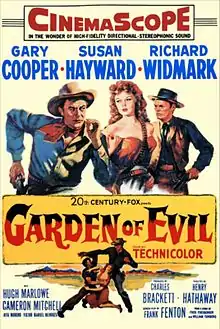Garden of Evil
Garden of Evil is a 1954 American Western film directed by Henry Hathaway, about three somewhat disreputable 19th-century soldiers of fortune, played by Gary Cooper as an ex-lawman, Richard Widmark as a gambler, and Cameron Mitchell as a bounty hunter, who are randomly hired by a woman, portrayed by Susan Hayward, to rescue her husband (Hugh Marlowe). Rita Moreno appears at the beginning of the film as a Mexican cantina singer/dancer.
| Garden of Evil | |
|---|---|
 | |
| Directed by | Henry Hathaway |
| Produced by | Charles Brackett |
| Screenplay by | Frank Fenton |
| Story by | Fred Freiberger William Tunberg |
| Starring | Gary Cooper Susan Hayward Richard Widmark |
| Music by | Bernard Herrmann |
| Cinematography | Milton R. Krasner Jorge Stahl, Jr. |
| Edited by | James B. Clark |
| Color process | Technicolor |
Production company | 20th Century Fox |
| Distributed by | 20th Century Fox |
Release date |
|
Running time | 100 minutes |
| Country | United States |
| Language | English |
| Budget | $2,070,000[1] |
| Box office | $3.1 million (US rentals)[2] |
Plot
En route to California to prospect for gold, ex-sheriff Hooker (Gary Cooper), professional gambler Fiske (Richard Widmark) and bounty hunter Luke Daly (Cameron Mitchell) are forced to stop over in a tiny Mexican village by engine trouble on the ship they are taking. A desperate Leah Fuller (Susan Hayward) hires the three men and local Vicente Madariaga, to rescue her husband, John (Hugh Marlowe), who is pinned under debris from a gold mine cave-in in hostile Apache territory.
During the harrowing journey, Daly tries to force himself on Leah late one night, forcing Hooker to intervene. Leah tells Hooker that where her husband is trapped, was once a boom town, but a volcanic eruption wiped it out, leaving only a church steeple and the mine uncovered by lava. The resident priest called it the "garden of evil". The Indians now consider the volcano sacred. The group then arrives at the mine. Finding John unconscious, they free him.
Before John wakes up, Hooker sets the man's broken leg. When John regains consciousness, he accuses Leah of using him to get gold. Hooker talks to Leah later, about what her husband said; after he tells her that he has spotted signs of Apaches nearby, she offers him and the others all the gold they have dug up to take her husband away that night, while she remains behind to make it look like they are all still there. The cynical Fiske unexpectedly offers to stay with her, but when he asks her what he is to her, she tells him, "you're nothing at all, just nothing."
When they are ready to leave, Leah is true to her word, but Hooker knocks her out and takes her along. When they stop to rest, realizing he is fatally slowing them down, John talks Luke into helping him onto a horse; he then rides off. When Hooker shows up, Daly draws his pistol, but is killed by an arrow in the back. At a burnt-out mission, they find John dead and hung upside down on a cross. Vicente is the next to fall. At a choke point in the cliff-hugging path, which is the only way out, the two remaining men draw cards to see who will stay behind to hold off the Indians while the other rides with Leah to safety. Fiske "wins" and succeeds in killing or driving off most of their pursuers. After seeing that Leah is safe, Hooker shoots a few more Apaches and returns to talk with a dying Fiske, who admits he cheated on the card draw to guarantee he would stay behind. Fiske urges Hooker to settle down with Leah. Hooker catches up with Leah, and they ride off into the sunset together.
Cast
- Gary Cooper as Hooker
- Susan Hayward as Leah Fuller
- Richard Widmark as Fiske
- Hugh Marlowe as John Fuller
- Cameron Mitchell as Luke Daly
- Rita Moreno as Cantina singer
- Víctor Manuel Mendoza as Vicente Madariaga
Production
The working title for the film was Volcano, it was changed because "there is an Italian pic of same title now playing U.S. art houses", a 1950 film directed by William Dieterle and starring Rossano Brazzi and Anna Magnani.
Robert L. Jacks was originally set to produce, but he left Twentieth Century-Fox to join Panoramic Productions and was replaced by Charles Brackett.
Outdoor sequences were shot on location in Mexico: at "the colonial town" of Tepotzotlán, in the jungle areas near Acapulco, Parícutin volcano with the church ruin of San Juan Parangaricutiro, and the village of Guanajuato with the then unrestored church ruin of Templo Santiago Apóstol, Marfil. Interior scenes were also shot at the Churubusco Studios in Mexico City.[3]
Reception
The New York Times reviewer wrote that "Although the story and its fireworks are interesting, they are dwarfed by the rugged mountains and lush coconut and banana tree jungles of the film's natural settings."[4]
See also
References
- Solomon, Aubrey. Twentieth Century Fox: A Corporate and Financial History. The Scarecrow Filmmakers Series. Lanham, Maryland: Scarecrow Press, 1989. ISBN 978-0-8108-4244-1. p249
- "The Top Box-Office Hits of 1954", Variety Weekly, January 5, 1955
- imdb.com Filming & Production
- A. W. (July 10, 1954). "Three Films Arrive; Garden of Evil' Has Debut at the Roxy Apache,' at Mayfair, Stars Lancaster [sic]". The New York Times.
External links
- Garden of Evil at the TCM Movie Database
- Garden of Evil at IMDb
- Garden of Evil at AllMovie